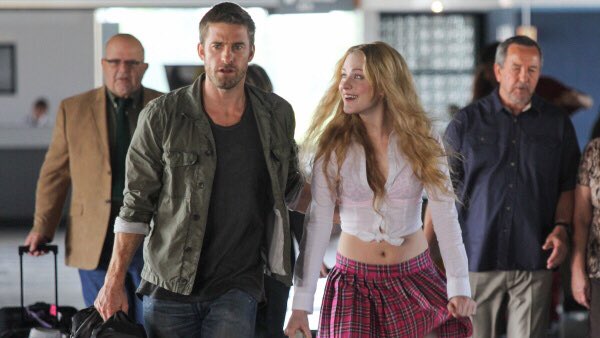In the vast realm of romantic dramas, Barefoot (2014) stands out as a gentle yet profound story that tugs at the heartstrings. Directed by Andrew Fleming, this unconventional love story navigates themes of innocence, redemption, and the healing power of connection. Though it didn’t achieve blockbuster success, Barefoot has garnered a quiet cult following among viewers who appreciate its heartfelt narrative and charming performances. Let’s take a deep dive into this underappreciated gem.
Plot Overview
Barefoot introduces us to Jay Wheeler (played by Scott Speedman), the black sheep of a wealthy family. Jay is a troubled man, grappling with a past marred by bad decisions, debts, and a knack for self-destruction. Fired from his job as a janitor in a psychiatric hospital due to gambling debts, Jay’s life takes a turn when he meets Daisy Kensington (Evan Rachel Wood), a sheltered and naïve young woman who has spent her entire life in isolation under the care of her overprotective mother. Daisy, who is emotionally fragile yet curious about the world, represents innocence in its purest form.
The story unfolds when Jay impulsively decides to take Daisy home to meet his family during his brother’s wedding, pretending she is his girlfriend to regain his parents’ approval. What begins as a calculated ploy to clean up his image evolves into a journey of emotional discovery for both Jay and Daisy. Together, they learn about trust, compassion, and the redemptive power of love.
The Characters and Performances
At the heart of Barefoot lies the chemistry between its two leads.
- Jay Wheeler: Played with a mix of charm and vulnerability by Scott Speedman, Jay is a character who is easy to root for despite his flaws. Speedman captures Jay’s inner turmoil and redemption arc beautifully, making his transition from selfishness to selflessness believable and endearing.
- Daisy Kensington: Evan Rachel Wood delivers a standout performance as Daisy, portraying her with a childlike wonder that never feels forced or exaggerated. Daisy’s innocence, contrasted with her strength and curiosity, makes her a fascinating character. Wood’s ability to balance fragility and resilience adds depth to Daisy’s role, making her more than just a damsel in distress.
The supporting cast, including Treat Williams and Kate Burton as Jay’s parents, also deserve recognition for grounding the film with relatable familial dynamics.
Themes and Symbolism
Barefoot explores several universal themes that resonate deeply with audiences:
- Innocence vs. Corruption: Daisy’s untainted perspective on life serves as a counterpoint to Jay’s jaded outlook. Her lack of worldly experience doesn’t make her weak; instead, it makes her uniquely strong and insightful. Through Daisy, the film emphasizes the value of looking at the world with fresh eyes and appreciating its simple beauties.
- Redemption: Jay’s character arc is the backbone of the story. His journey from a reckless, self-centered man to someone capable of genuine love and responsibility mirrors the broader theme of redemption. The film subtly suggests that redemption isn’t just about making amends; it’s about finding the courage to change for the better.
- Human Connection: The film underscores the transformative power of human relationships. Both Jay and Daisy are broken in their own ways, but their connection helps them heal. Their relationship is a testament to the idea that love, when genuine, has the power to transcend past mistakes and personal flaws.
- Stepping Out of Comfort Zones: Daisy’s decision to leave her isolated life behind and Jay’s willingness to confront his family and past mistakes reflect the courage it takes to step out of one’s comfort zone. This theme is beautifully symbolized by Daisy walking barefoot—a literal and metaphorical representation of vulnerability and freedom.
Visual Storytelling and Direction
Andrew Fleming’s direction ensures that Barefoot is more than just a romantic drama. The film’s visual storytelling is simple yet evocative, with an emphasis on natural light and intimate framing. The decision to portray Daisy barefoot throughout the movie isn’t just a quirky character trait; it becomes a symbol of her unfiltered connection to the world around her. The use of close-ups, particularly during key emotional moments, draws viewers into the characters’ inner worlds, making their journey feel personal and relatable.
The film’s pacing, while deliberate, allows for moments of reflection and emotional depth. It may not be packed with high-octane drama or twists, but its quiet, character-driven approach makes the story feel authentic.
Reception and Criticism
Despite its heartfelt narrative and strong performances, Barefoot received mixed reviews from critics. Some felt the story leaned too heavily on clichés, while others criticized its portrayal of mental health issues as overly simplistic. However, audiences who connected with the film’s emotional core often found it to be a touching and uplifting experience.
One notable critique of the film is its handling of Daisy’s character. While many viewers appreciated her innocence, others felt her portrayal bordered on idealized and lacked nuance, making her appear more as a plot device than a fully fleshed-out character. Similarly, the film’s resolution, though satisfying, may feel predictable to some.
Why Barefoot Deserves More Recognition
In an era dominated by grand, action-packed blockbusters and dark, gritty dramas, Barefoot offers a refreshing change of pace. It’s a film that wears its heart on its sleeve, unapologetically embracing its sentimental side. While it may not reinvent the romantic drama genre, it succeeds in delivering a story that feels genuine and emotionally resonant.
What sets Barefoot apart is its focus on small, meaningful moments. From Daisy’s wide-eyed wonder at experiencing everyday life for the first time to Jay’s gradual realization of his capacity for love, the film finds beauty in the mundane. These moments remind us that life’s simplest experiences—holding hands, dancing, or even walking barefoot—can hold profound significance.
Final Thoughts
Barefoot is more than just a love story; it’s a meditation on humanity, resilience, and the transformative power of connection. While it may not appeal to everyone, those who appreciate intimate, character-driven narratives will find much to love in this film.
Evan Rachel Wood and Scott Speedman’s performances elevate the story, bringing warmth and authenticity to their characters’ journey. Whether you’re a fan of romantic dramas or simply looking for a heartfelt film that leaves you with a smile, Barefoot is worth a watch.
In the end, Barefoot reminds us that sometimes, the path to redemption and happiness begins with the simple act of letting go and embracing life with open arms—and perhaps, bare feet.


